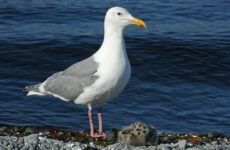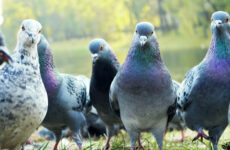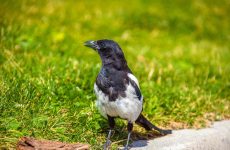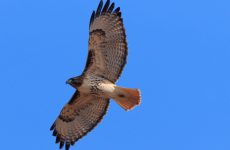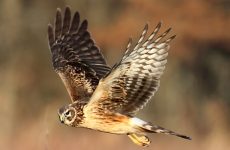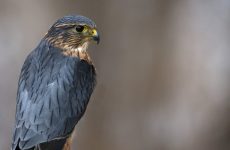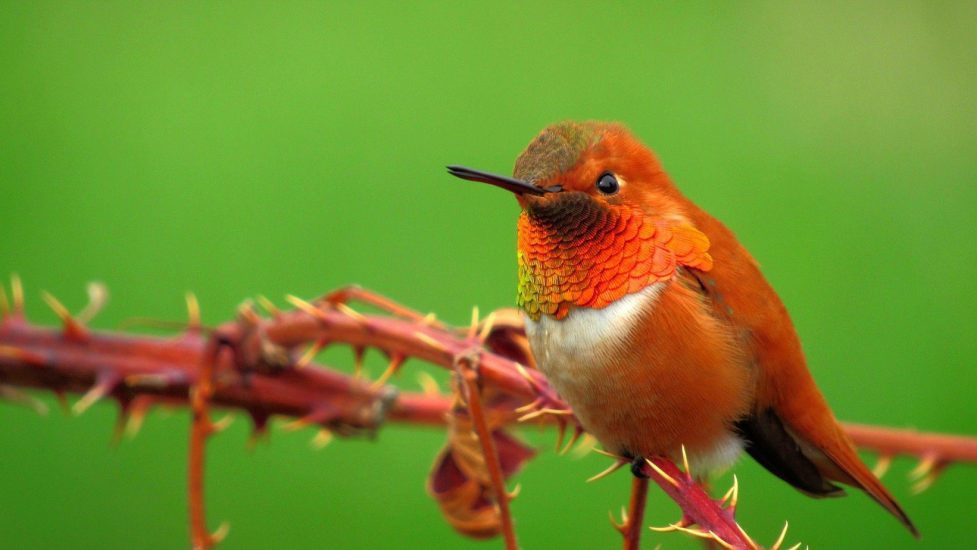
There are two main species of Hummingbird in Michigan but a total of 8 species are recognized in state bird records.
Species of hummingbirds are classed as resident, seasonal or rare in each state and according to avibase and accepted by the Michigan Bird Records Committee (MBRC) these are the types of hummingbird in Michigan in each group:
Resident Species of Hummingbirds of Michigan:
There are no species of hummingbird classed as residents in Michigan.
Seasonal Species of Hummingbirds of Michigan:
Ruby-throated Hummingbirds, Rufous Hummingbirds are seasonal species of Humminbird in Michigan.
Rare/Accidental Species of Hummingbirds of Michigan:
Mexican Violetears are considered casual species as they can wander. Costa’s Hummingbirds, White-eared Hummingbirds, Berylline Hummingbirds, Anna’s Hummingbirds, and Broad-billed Hummingbirds are all considered to be accidental visitors to Michigan.
Most of these accidental species have only been seen a few times in Michigan.
Read on to find out everything you need to know about hummingbirds in Michigan.
Rushed for time then check out this quick photo guide of male vs. female hummingbirds.
Find out how to attract hummingbirds with plants and flowers. Also how to make your own sugar water.
8 Species of Hummingbirds Michigan
1. Ruby-throated Hummingbird
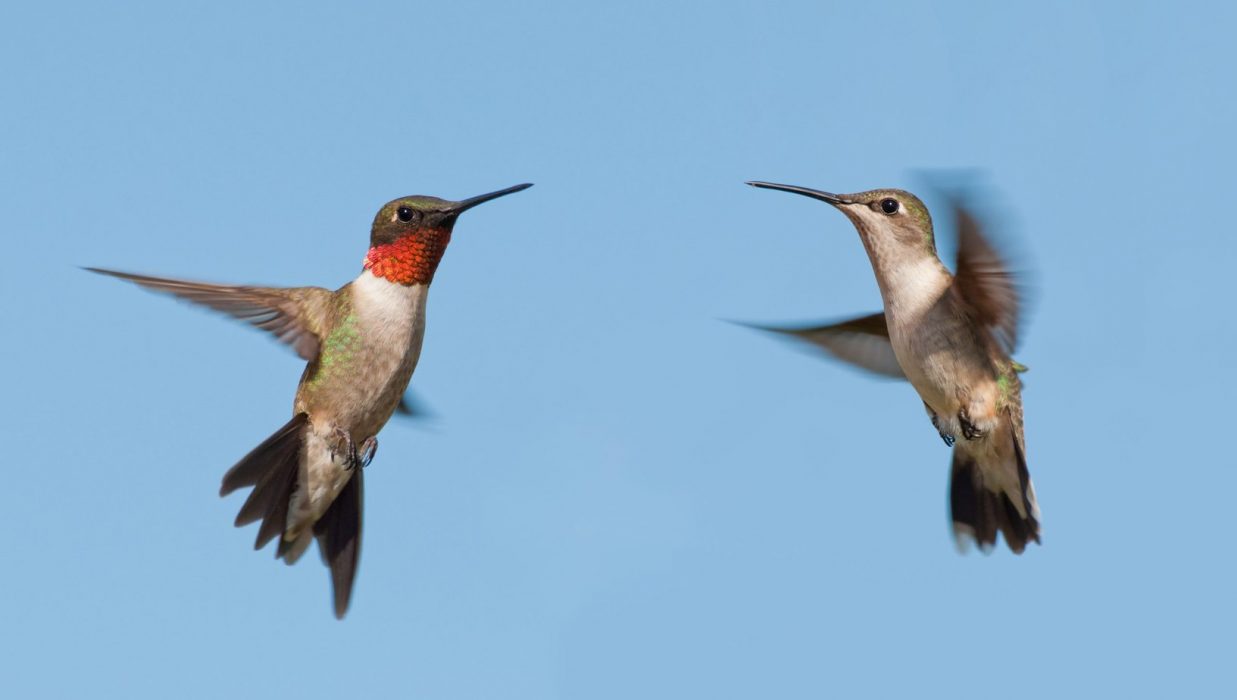
Ruby-throated Hummingbirds of Michigan are a common sight in summer and they usually start to arrive in spring in April but mostly in May. Males usually arrive first up to one or two weeks before the females. In the fall migration usually occurs between September to Mid-October.
The Ruby-throated Hummingbirds are bright green on the back and crown, with a gray-white underside and the males have an iridescent red throat. Female Ruby-throated Hummingbirds are green on the back and white underneath with brownish crowns and sides.
- Length: 2.8-3.5 in (7-9 cm)
- Weight: 0.1-0.2 oz (2-6 g)
- Wingspan: 3.1-4.3 in (8-11 cm)
The Ruby-throated Hummingbird is the only breeding hummingbird in eastern North America, they then migrate further south to Central America. Some migrate over the Gulf of Mexico or some migrate through Texas around the coast.
They start arriving in the far south in February and may not arrive in northern states and Canada until May for breeding. They start to migrate south in August and September.
These tiny birds zip from one nectar source to the next or catch insects in midair or from spider webs. They occasionally stop on a small twig but their legs are so short they cannot walk, only shuffle along a perch.
Flowering gardens or woodland edges in summer are the best places to find them when out. They are also common in towns, especially at nectar feeders.
Male Ruby-throated Hummingbirds can be aggressive in their defense of flowers and feeders. They do not stick around long after mating and may migrate by early August.
Ruby-throated females build nests on thin branches and make them out of thistle or dandelion down held together with spider silk. They lay 1-3 tiny eggs measuring only 0.6 in (1.3 cm)
2. Rufous Hummingbird
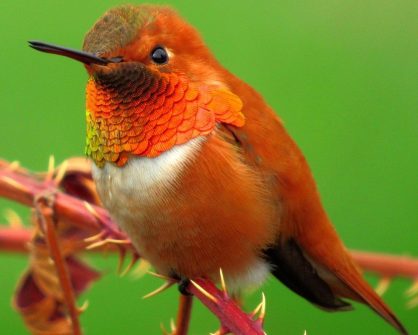
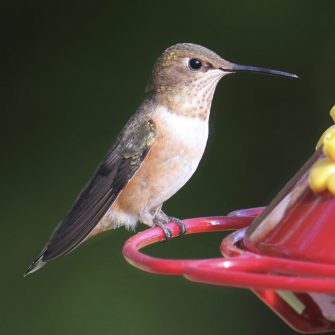
Rufous Hummingbirds are not very common in Michigan but a few each year do wander this far north in winter. They are found in the south of Michigan. A good reason to keep your hummingbird feeders out in winter.
Rufous Hummingbirds are bright orange on the back and belly, a white patch below the throat, and an iridescent red throat in the males. The females are greenish-brown on the back and rusty colored on the sides with a whitish belly.
- Length: 2.8-3.5 in (7-9 cm)
- Weight: 0.1-0.2 oz (2-5 g)
- Wingspan: 4.3 in (11 cm)
Rufous Hummingbirds are one of the longest migrating birds relative to their size, traveling up to 4000 miles each way. They breed in northwest Alaska and migrate down to Mexico and the Gulf Coast for winter.
They migrate north along the Pacific Coast in spring and by the Rocky Mountains in late summer and fall.
Rufous Hummingbirds feed mostly on nectar from colorful tubular flowers and from insects such as gnats, midges, and flies. They build a nest high up in trees using soft plant down and spider webs to hold it together. They lay 2-3 tiny white eggs that are about 0.5 in (1.3 cm) long.
They are very aggressive and chase off any other hummingbirds that may appear, even larger hummingbirds or resident ones during migration. During migration, they won’t hang around long and will chase off most other hummingbirds even a chance. They can be found in mountain meadows and in winter they live in woods and forests.
3. Mexican Violetear
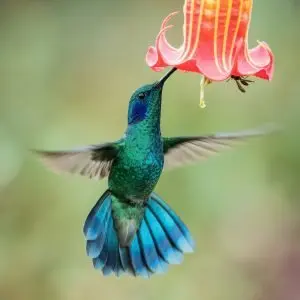
Mexican Violetears have only been spotted in Michigan a few times in summer near Lake Superior but not for many years.
Mexican Violetears are medium-sized hummingbirds that are metallic green with violet patches on the sides of their heads and breasts.
Males and females are similar but males are slightly larger and brighter.
- Length: 3.8 – 4.7 in (9.7 – 12 cm)
- Weight: 0.17 – 0.2 oz (4.8 – 5.6 g)
Mexican Violetears breed in forests in Mexico and through Central America to Nicaragua but can be found as far south as the mountains in Bolivia and Venezuela.
Some non-breeding Mexican Violetears may fly north into the United States more commonly to Texas, but some have been spotted as far north as Michigan but very rarely.
Find out how to attract hummingbirds with plants and flowers. Also how to make your own sugar water.
4. Costa’s Hummingbird
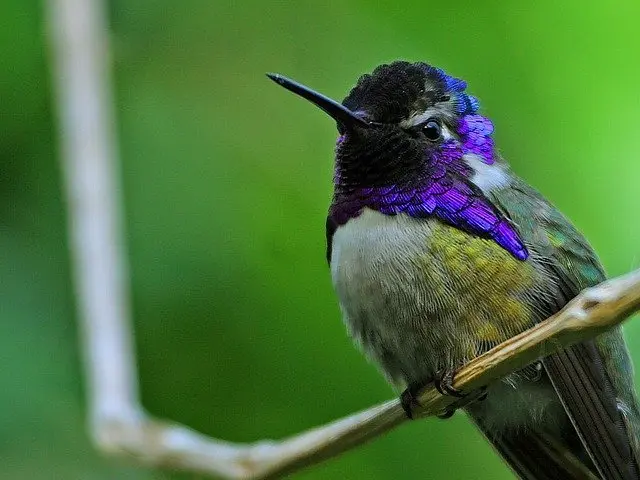
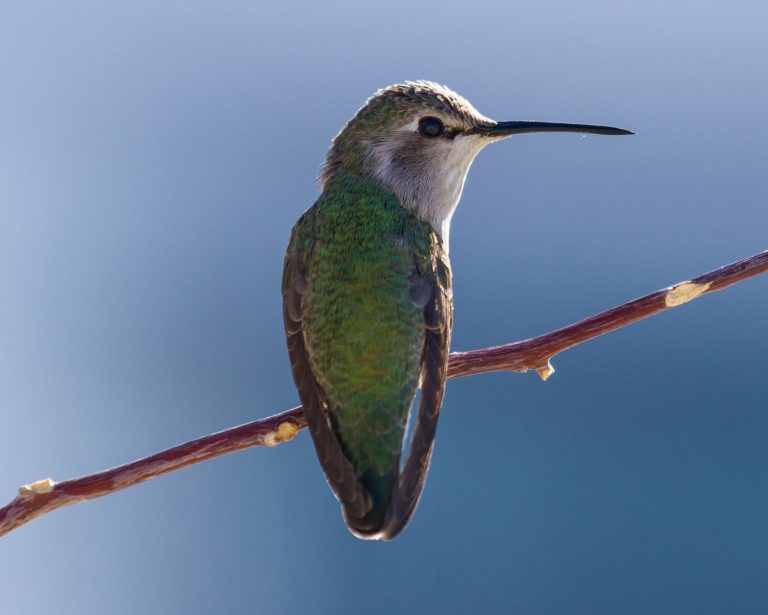
Costa’s Hummingbirds are an accidental species in Michigan and have rarely been seen.
Costa’s Hummingbirds are predominantly desert hummingbirds with striking iridescent purple throat patches that flare out and a purple crown. Their backs are green and their bellies are white with green coloring on the sides. Female Costa’s Hummingbirds lack the purple color and are more white on the belly.
- Length: 3.5 in ( 7.6 – 8.8 cm)
- Weight: 0.1-0.1 oz (2-3 g)
Costa’s Hummingbirds are residents in Baja California and southern California and southwestern Arizona. They also migrate between the Pacific Coast of Mexico in winter and up into Arizona, the southern edges of Nevada and Utah, and California for breeding.
Desert scrub, chaparral, and deciduous forest provide the habitat of Costa’s Hummingbirds and they visit many different species of plants. Nests are built quite low at three to seven feet above the ground in shrubs and they may have up to two broods in a year.
5. White-eared Hummingbird
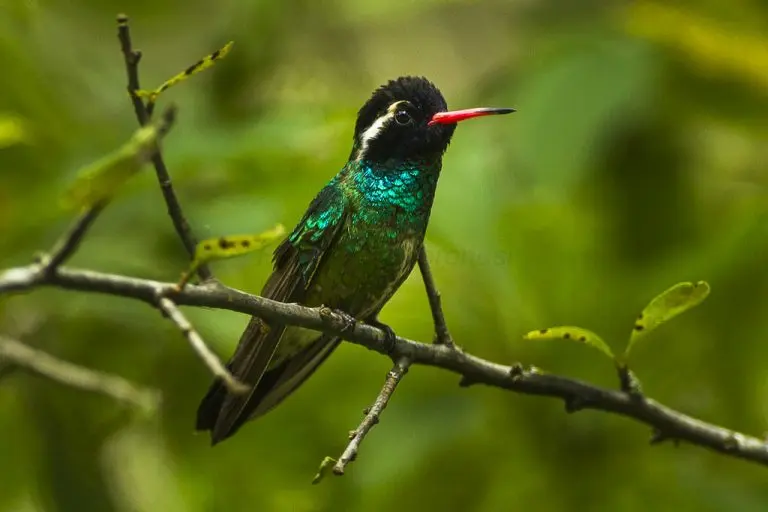
White-eared Hummingbird male (credit:Francesco Veronesi )
White-eared Hummingbirds are an accidental species in Michigan and have only been a confirmed sighting in 2005 and unfortunately have not been seen here since.
White-eared Hummingbirds are green on their backs and breasts with a black head and a white eyestripe on both males and females. Their beaks are red with a black tip. Males have a metallic turquoise green throat with violet patches on the face.
- Length: 3.5 – 4 in (9-10 cm)
- Weight: 0.1 – 0.14 oz (3-4 g)
White-eared Hummingbirds range from Nicaragua up to the mountains in southeastern Arizona, southwestern New Mexico, and western Texas but they are rare in the United States. They usually nest between March to August in northern and central Mexico or later in July in Arizona and they may have 3 broods in a year. They migrate to arrive in the southern United States in March and leave by early September.
Scrubby growth and forests or backyards provide the habitat of White-eared Hummingbirds and they nest in shrubs or low trees.
6. Berylline Hummingbird
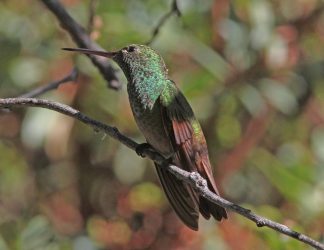
Berylline Hummingbirds are an accidental species of Hummingbird in Michigan. There was a rare event in 2014 that has not been repeated so don’t get your hopes up, you will have to head south.
Berylline Hummingbirds are metallic green with a gray lower belly and reddish in the wings. Females are less colorful than males and are slightly smaller. Their upper bills are black and the lower bill is reddish-orange.
- Length: 3 – 4.25 in (8-11 cm)
- Weight: 0.14 – 0.18 oz (4-5 g)
They range from Mexico to Honduras in open woodlands of oak and pine and shady canyons and they will also stray up into southeastern Arizona. They are usually solitary birds and can be aggressive in defending their territory including at hummingbird feeders.
The only place in North America that Berylline Hummingbirds can be found is in southeastern Arizona in the Santa Rita Mountains, Huachuca Mountains, and Chiricahua Mountains during breeding between April and November.
7. Anna’s Hummingbird
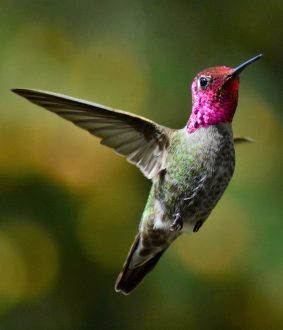
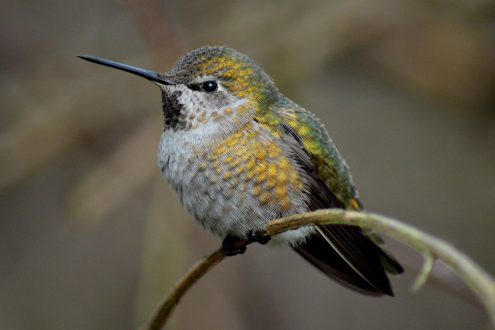
An accidental species of hummingbird in Michigan, Anna’s Hummingbirds has been spotted only a few times in the state in winter.
Anna’s Hummingbirds are tiny birds that are mostly green and gray. The male’s head and throat are iridescent reddish-pink the female’s throat is grayish with bits of red spotting.
- Length: 3.9 in (10 cm)
- Weight: 0.1-0.2 oz (3-6 g)
- Wingspan: 4.7 in (12 cm)
Unusually Anna’s Hummingbirds do not migrate but some may move short distances in winter. They are the most common hummingbird along the Pacific Coast. They make a dramatic dive display during courtship as the males climb up to 130 feet into the air before diving back to the ground with a burst of noise from their tail feathers.
Habitats of Anna’s hummingbirds are often backyards and parks with large colorful blooms and nectar feeders but they are also found in scrub and savannah.
Anna’s Hummingbirds’ nests are high in trees around 6 – 20 ft and they often have 2-3 broods a year.
8. Broad-billed Hummingbird
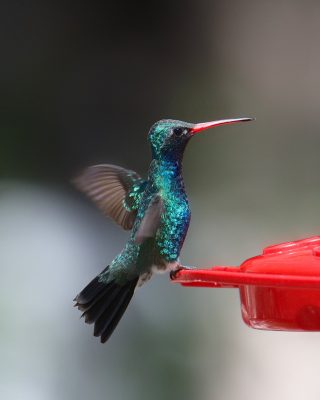
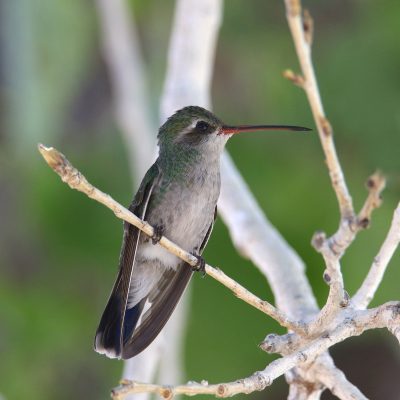
An accidental species of hummingbird in Michigan, the Broad-billed Hummingbird has only ever been spotted a few times in the state.
Broad-billed Hummingbirds are brilliantly colored, even among hummingbirds. The males are rich metallic green all over with a blue throat that extends down the breast. Females have a pale belly and both males and females have red beaks that are black-tipped and wide near their heads.
- Length: 3.1 – 3.9 in (8-10 cm)
- Weight: 0.1-0.1 oz (3-4 g)
Broad-billed Hummingbirds are resident all year in central Mexico and the Pacific Coast of Mexico. Some birds migrate north into mountain canyons in southern Arizona and New Mexico, for breeding and a few remain all year near the Mexican border.
Canyon streams and mountain meadows provide the ideal foraging areas for Broad-billed Hummingbirds but they will also visit backyard feeders. Nests are built quite low to the ground at about 3 feet near streams.
Also, check out these great articles about birds in Michigan:
Best Nectar Feeders to Attract Hummingbirds in Michigan
This site is reader-supported and as an Amazon Associate, I earn a commission if you purchase a product I recommend at no extra cost to you.
The more the merrier with Hummingbirds is what I think and they can be territorial so getting a few hummingbird feeders around your backyard is best. We have picked the best hummingbird feeders for you to get hummingbirds buzzing all over your yard.
- Best window mounted hummingbird feeder – Perky-Pet Window Mount Hummingbird Feeder
- Try to count the wingbeats of the next hummingbird to use this feeder!
- Best all-round feeder – First Nature Hummingbird Flower Feeder
- Not only does this feeder feed a lot of hummingbirds at once it is so reasonably priced that you want to get more of them to fill up your yard with the buzz of hummers.
- Best decorative feeder– Grateful Gnome Hummingbird Feeder
- This Hand Blown Glass feeder not only looks great but attracts a lot of hummers.
How to Attract the Hummingbirds of Michigan to Your Backyard
If you would like to attract more hummingbirds to your yard in Michigan here are some tips:
- Provide more hummingbird feeders and spread them around your yard to create more territories.
- Ensure you clean and change the hummingbird nectar regularly. You can either buy nectar or make your own, but don’t use any with red dye.
- Provide a water feature such as a birdbath fountain or stream. Ensure that the water is clean and not stagnant
- Grow native plants that will provide food such as salvias, fuschias, trumpet creeper, lupin, columbine, bee balms, and foxgloves
- Don’t use pesticides and herbicides as these may be toxic to birds.
- Provide small perches of thin branches bare of leaves for hummingbirds to rest.
How to Identify Birds in Michigan
Here are some tips to help you identify birds whether you are out birding or backyard bird watching in Michigan:
- Size – Size is the easiest thing to notice about a bird. Birds are often measured in inches or centimeters in guide books. It’s best to take a note of the bird in terms of small, medium, or large to be able to look for it later. A small bird is about the size of a sparrow, a medium bird is about the size of a pigeon and a large bird is the size of a goose.
- Shape – Take note of the silhouette of the bird and jot it down or draw the outline. Look at tail length, bill shape, wing shape, and overall body shape.
- Color pattern – Take a note of the main color of the head, back, belly, and wings, and tail for the main color and then any secondary colors or patterns. Also take note of any patterns such as banding, spots, or highlights.
- Behavior – Are they on the ground or high up in the trees. Are they in flocks or on their own? Can you spot what they are eating?
- Habitat – Woodlands, parks, shrubs, grasslands or meadows, shore or marsh.
- Use a bird identification app such as those created by ebird or Audubon

